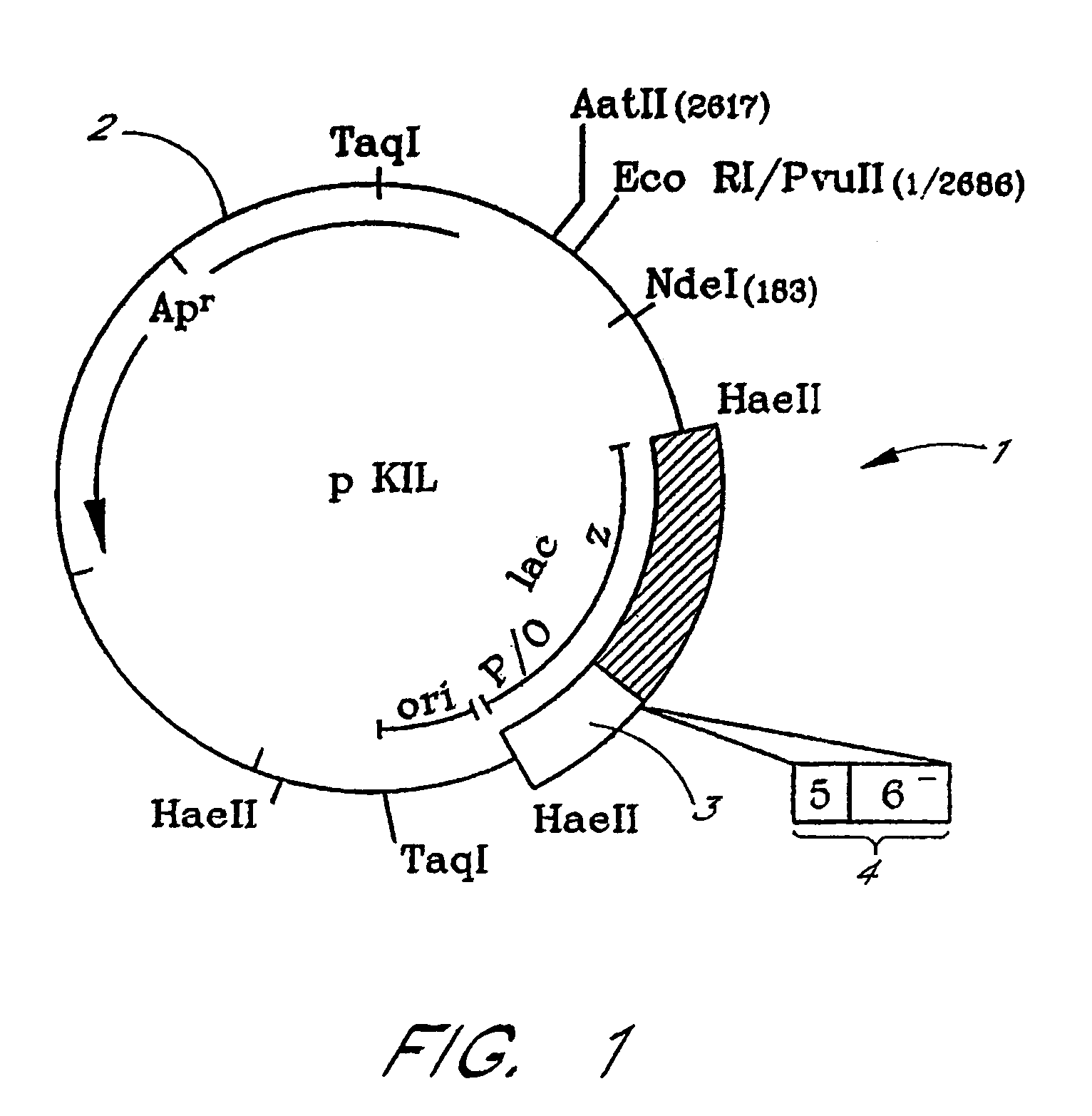Cloning and/or sequencing vector
a technology of cloning and sequencing, applied in the field of cloning and/or sequencing vectors, can solve the problems of cytotoxic gene completely repression, unstable and awkward use, and high cost of the blue screen technique, and achieve the effect of being relatively inexpensive to construct and produ
- Summary
- Abstract
- Description
- Claims
- Application Information
AI Technical Summary
Benefits of technology
Problems solved by technology
Method used
Image
Examples
example i
Construction of the Plasmid PKIL19
[0069]The ccdB gene was amplified by PCR using, as DNA template, the plasmid pULB2208 (Bernard and Couturier, The 41 carboxy-terminal residues of the miniF plasmid CcdA protein are sufficient to antagonise the killer activity of the CcdB protein, Mol. Gen. Genet. 226, 297–304 (1991) as well as synthetic oligonucleotides.
[0070]The synthetic oligonucleotide sequences were selected in such a way as to create an EcoRI restriction site on either side of the wild-type ccdB gene in order to be able to reclone this gene in frame with the codons of the MCS19 multiple cloning site and to eliminate the initiation codon of the native ccdB gene. The DNA resulting from the PCR reaction was digested with the enzyme EcoRI and cloned into the EcoRI site of the plasmid pUC19. The resulting plasmid, in which the EcoRI fragment was integrated in the orientation which permitted the ccdB gene, provided with the additional codons corresponding to the MCS19 multiple clonin...
example ii
Construction of the Plasmid pKIL18
[0073]The ccdB gene was amplified by PCR using, as DNA template, plasmid pKIL19 as well as synthetic oligonucleotides. The sequences of the synthetic oligonucleotides were selected in such a way as to create a HindIII site on either side of the ccdB gene in order to be able to reclone this gene in frame with the codons of the MCS18 multiple cloning sites. The DNA resulting from the PCR reaction was digested by the enzyme HindIII and cloned into the HindIII site of the plasmid pUC18. The resulting plasmid, in which the HindIII fragment was integrated in the orientation which permitted the ccdB gene, provided with the additional codons corresponding to the MCS18 multiple cloning sites, to be read from the Lac promoter, was termed pKIL4. Plasmid pKIL4 is lethal for a CcdbS-sensitive bacterium.
[0074]The HindIII site downstream of the ccdB gene was eliminated by filling in its cohesive ends. The resultant plasmid, pKIL18 ((SEQ ID NO:4 and SEQ ID NO:6), p...
example iii
Construction of the Plasmid pKID18
[0075]ParD is a killer stability system of R1 plasmid located in the proximity of the basic replicon. It is a small operon containing two genes, Kid and Kis, coding for a killer component and its antagonist respectively (Bravo et al., Mol. Gen. Genet., Vol. 215, pp. 146–151 (1988)). This system is perfectly conserved and functional in another incFII plasmid, R100 (pem system: Tsuchimoto et al., J. of Bacteriol., Vol. 170, pp. 1461–1466 (1988)), PemA (identical to Kis) and PemB (identical to Kid).
[0076]The vectors pKID18 and pKID19 contain the Kid gene fused to different polylinkers (MCS18 and MSC19 for pKID18 and pKID19 respectively). The Kid sequence was amplified by PCR from the plasmid R1 drd19 using the primers kid1—gaggaattcattgggaaagaggggaaatctg—(SEQ ID NO:7) and kid2—gaggaattctcaagtcagaatagtggaca—(SEQ ID NO: 8). The generated insert was cloned into the EcoRI site of pUC19 (Yanish-Perron et al. (1985)). This insertion generates a fusion gene b...
PUM
| Property | Measurement | Unit |
|---|---|---|
| color | aaaaa | aaaaa |
| size | aaaaa | aaaaa |
| resistance | aaaaa | aaaaa |
Abstract
Description
Claims
Application Information
 Login to View More
Login to View More - R&D
- Intellectual Property
- Life Sciences
- Materials
- Tech Scout
- Unparalleled Data Quality
- Higher Quality Content
- 60% Fewer Hallucinations
Browse by: Latest US Patents, China's latest patents, Technical Efficacy Thesaurus, Application Domain, Technology Topic, Popular Technical Reports.
© 2025 PatSnap. All rights reserved.Legal|Privacy policy|Modern Slavery Act Transparency Statement|Sitemap|About US| Contact US: help@patsnap.com

